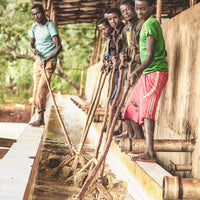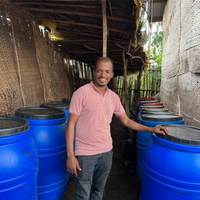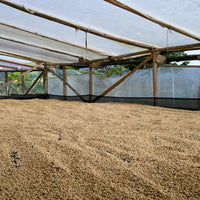Origin: Burundi
Region: Kayanza
Altitude: 1700 - 1900 meters above sea level
Farm: various community small-holders
Washing Station: Nemba
Owner: Green Co
Variety: Bourbon
Process: Yeast Inoculated (Cima) Dry Natural
Tasting Notes: Boozy and bold with notes of dark berries, chico lollies and pineapple.
Nemba station lies in the northern province of Kayanza. Each washing station is managed and lead by an agronomist. This agronomist oversees the implementation of Good Agricultural Practices (GAPs) and farmer education. They collaborate with the producers to ensure they have access to the necessary farming tools. The agronomist also helps farmers determine and implement the practices best suited to the specific growing conditions of their farming plots.
Nemba uses a monitoring system to ensure traceability all along the production and processing chain. All 3,000+ producers are smallholders who own an average of 150 coffee trees. The farms delivering cherry to Nemba are all located around 1,700+ meters above sea level, near the Kibila forest. The washing station has over two hundred drying tables and can process up to 750 metric tons of coffee cherry annually.
Most coffee trees in Burundi are Red Bourbon for reasons of quality. Because of the increasingly small size of coffee plantings, aging rootstock is a very big issue in Burundi. Many farmers have trees that are over 50 years old, but with small plots to farm, it is difficult to justify taking trees entirely out of production for the 3-4 years it will take new plantings to begin to yield. In order to encourage farmers to renovate their plantings, Greenco purchases seeds from the Institut des Sciences Agronomiques du Burundi (ISABU), establishes nurseries and sells the seedlings to farmers at or below cost.
During the harvest season, all coffee is selectively handpicked. Most families only have 200 to 250 trees, and harvesting is done almost entirely by the family.
Cherry is placed in Epoxy-coated concrete fermentation tanks. Cima yeast purchased from the French company Lalcafe is added to the tanks. The tanks are left to ferment in this environment for approximately 48 hours.
Cherry is placed in airtight containers and Cima yeast purchased from the French company Lalcafe is added to the tanks. The tanks are then covered and left to ferment in this environment for approximately 36 hours.
LALCAFÉ CIMA™ yeast (Saccharomyces cerevisiae) was especially developed for coffee production over a four-year period of research and trials. Trials in various regions and environments showed that Cima is well suited to better control the wet process’ efficiency and to upgrade the cup quality. The yeast is able to control the fermentation process against the risk of spoilage micro-organisms that can generate undesirable defects. Furthermore, its specific metabolism and its high capacity of implantation even at cold temperatures (minimum 15°C inside the coffee tank) allows for the expression of fresh and fruity characteristics of the coffee beans while respecting the varietal original aromas of the beans. The longer fermentation time for yeast processed coffees also allows for more developed flavors. The extra time enables the beans to absorb metabolites, which can enhance flavors. Complexity, acidity, brightness, floral and high notes and more are all boosted by the lengthened fermentation time.
After fermentation, cherry is carried to the drying tables, where they will dry slowly for 2-3 weeks, during which time the cherry is repeatedly sorted and sifted to ensure even drying. Cherry is left to dry from sunrise to sunset and is covered with a sheet during the evening or when it rains. The moisture level is carefully monitored and any cherry with visual defects is removed.
Once dry, coffee is then bagged and taken to the warehouse. Greenco’s team of expert cuppers assess every lot (which are separated by station, day and quality) at the lab. The traceability of the station, day and quality is maintained throughout the entire process.







